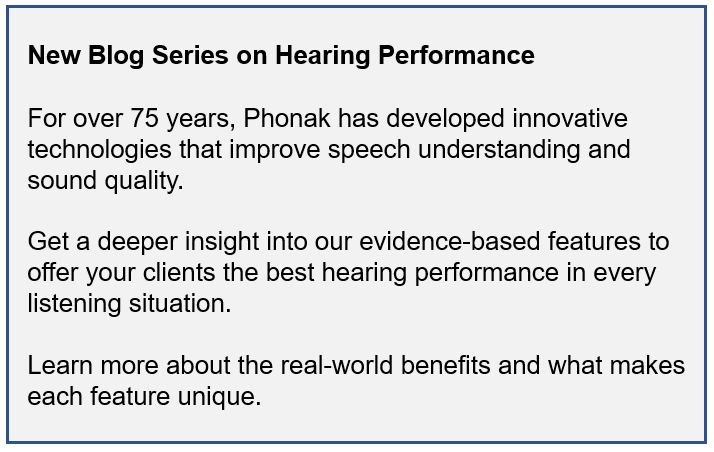
Directionality and noise reduction features: 3 real-world problems they solve
Understanding speech in noisy environments is ranked a top need of those with hearing loss. Here is how directionality and noise reduction features in Phonak hearing aids can help.
Did you know that understanding one-to-one and group conversations in noise were ranked in the top ‘most important’ listening situations for hearing aid users.1
This is an important finding because difficulties hearing in noise is a common symptom of hearing loss.2 I’m sure you agree that many of your clients report struggling to hear conversations in noise.
So, how do we best address noise management so your clients can enjoy conversations in noise, whether one-to-one or in groups?
When it comes to conversing in noise, there is a link between speech understanding and Phonak directionality and noise reduction features.
3 real-world benefits of Phonak directionality and noise reduction features:
- Improved speech understanding in noise – Whether speech comes from the front, side or behind (e.g., watching a sports game and a friend sitting next to you is talking), directionality and noise reduction features help.
- Reduced listening effort in noise – The spatial noise cancellation system works in combination with directional microphones to reduce listening effort in noise.
- Increased environmental/spatial awareness – Directionality and noise reduction features provide more spatial awareness from both sides, even when in noise.
The first directional microphone systems introduced were fixed. Over the years, technological advances led to the development of adaptive and multi-channel directional microphone systems.
Innovations in wireless transmission technology also enabled linking of the 4 microphones across two hearing aids to create a binaural beamformer.
This adaptive directionality is effective and can improve speech understanding in environments with low to moderate levels of environmental noise.6 For noisier environments, remote microphones, like Roger™ technology, can offer additional benefit.
What makes Phonak directionality and noise reduction features special?
- SpeechSensor
This automatic feature accurately detects the direction of speech to better understand speech from the side or back in noisy environments. A study showed 15% better speech understanding with SpeechSensor when speech is from the side/behind.3 - StereoZoom 2.0
This feature improves focus in noise or spatial awareness depending on the environment. It is a narrow binaural directional microphone mode launched with Phonak Audéo Lumity. A study showed 16% better speech understanding with StereoZoom 2.0, relative to fixed directional, for speech coming from the front.3 - Motion Sensor Hearing (MSH)
This feature uses a 3D motion sensor that detects movement and supports speech understanding in challenging environments (e.g., noisy), when on the move. A study compared the experience of a short walk with a conversation partner along a busy street, with and without MSH.4 They found that 73% preferred MSH for speech understanding, 78% for environmental awareness and 71% for overall listening experience. - Dynamic Noise Cancellation
This spatial noise cancellation system works in combination with directional microphones. This feature has been found to reduce listening effort in noise.5
References
- Appleton-Huber, J. (2022). Better listening in noise looms large for satisfying hearing aid users–especially older clients. Hearing Review. 29(6):10-16.
- NHS. (2018). Symptoms: Hearing loss. Retrieved from https://www.nhs.uk/conditions/hearing-loss/symptoms/, accessed November 28, 2022.
- Woodward, J. & Latzel, M. (2022). New implementation of directional beamforming configurations show improved speech understanding and reduced listening effort. Phonak Field Study News in preparation. Expected end of 2022.
- Appleton, J., & Voss S.C., (2020). Motion-based beamformer steering leads to better speech understanding and overall listening experience. Phonak Field Study News. Retrieved from ww.phonakpro.com/evidence, accessed November 28, 2022.
- Appleton, J. (2020). AutoSense OS 4.0 – significantly less listening effort and preferred for speech intelligibility. Phonak Field Study News. Retrieved from www.phonakpro.com/evidence, accessed November 28, 2022.
- Souza, P. (2021). 2 ways severe-to-profound hearing loss is just…different. Phonak Audiology Blog. Retrieved from https://audiologyblog.phonakpro.com/2-ways-severe-to-profound-hearing-loss-is-just-different/, accessed November 28, 2022.

To learn more about the features in Phonak Audéo™ Lumity, we invite you to visit our webpages.
